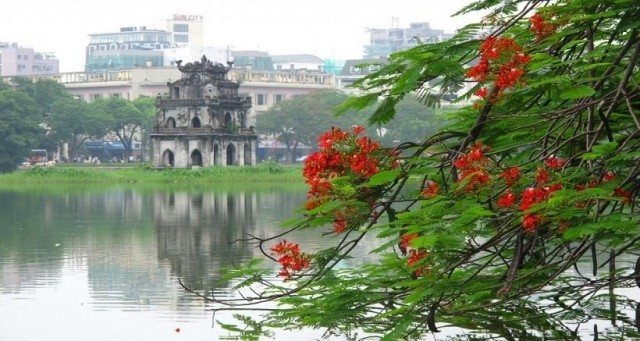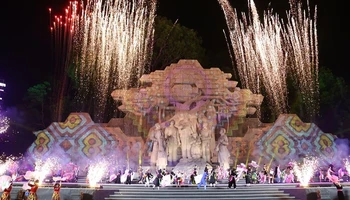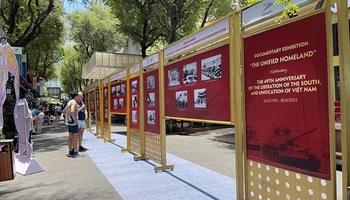Residents of Xuan Hoa ward in Phuc Yen, a city in Vinh Phuc province, almost had a chance to share in the joy as the capital city celebrates its expansion. The legacy of a time several decades ago when Xuan Hoa was part of Hanoi can still be seen in the name of Hanoi Education University II, which is located here. Later generations might ask why a Hanoi college is situated in Vinh Phuc province. The answer is simple: the ward where the institution is located used to be a part of the capital city.
Ten years after the geographical boundary expansion came into effect, Hanoi has recorded many social and economic achievements. To date, many still cast doubt over the decision but clearly there are many positives. Had Ha Tay province not been merged into Hanoi, would progress on the Thang Long Boulevard and National Highway have been expedited so that they became main arteries connecting the city centre to its western areas as they are today?
The communities of ethnic minority people in Ba Vi and Thach That districts have also been given greater attention over the past ten years. With much of its territory now comprising vast rural areas which were once part of Ha Tay province, Hanoi has also been named a leader in the movement to build new rural areas over the past decade. Fears of a gradual loss of the unique culture in the western region of the capital city has also subsided after efforts were made to protect the cultures of both regions.
When Hanoi became larger, many were concerned that the population would double and further aggravate the already severe traffic congestion. Conversely, others were hopeful that a larger city could be the key to addressing Hanoi’s traffic woes.
They argued that Hanoi was overburdened because of migration driven by the desire of millions to become residents of the capital city. It was expected that people would flock to newly incorporated areas such as Son Tay, Ba Vi, Thach That, My Duc and Phuc Tho to fulfil their dreams of becoming Hanoi residents, instead of making every effort to remain in the old centre. Then the pressure on the old urban centre would be relieved.
Such a dream was cherished in a plan under which Hanoi would have five satellite towns, four of which used to be within the boundary of Ha Tay province. The satellite towns were envisioned to become magnets for large flows of people. And very quickly the old centre of Hanoi would become quiet and peaceful again, and traffic congestion would no longer be a problem.
It was the romantic dream of a generation.
Ten years is a relatively brief period in the 1,000-plus-year history of the capital city. Ten years ago, property was a buzzword and could be heard everywhere from the roadside beverage stalls to the office rooms. People from the old Hanoi rushed to the new Hanoi to purchase land. Deals were cut quickly as buyers feared that land owners would change their mind and sell their land to other buyers. New urban areas began to sprout up along the roads that connect the old Hanoi with the new Hanoi. Everything seemed to point to a population redistribution that would happen very soon.
Ten years ago, the extended section of Le Van Luong Street had not taken shape. Now, a jungle of high-rise buildings line the street. Just thinking of the streams of cars and scooters humming out of these concrete tower blocks will give anyone the shivers.
In the late 2000s, a leisurely stroll along Nguyen Tuan Street could still be made. But now almost everyone wants to get out of the place as quickly as possible in order to avoid being suffocated by the overwhelming concrete blocks.
A similar feeling could also be felt in Hoang Dao Thuy, Hoang Minh Giam and Vu Trong Phung Streets. Ten years ago, high-rise buildings were few and far between in Hanoi. Urban areas that used to be considered highly liveable such as Linh Dam and Trung Hoa-Nhan Chinh are now densely filled with high-rise tower blocks.
On the contrary, urban areas along the Thang Long Boulevard, National Highway 32 or those situated in former Ha Tay province are still far from being filled up with residents. Little changes are seen in the five satellite towns. People still steadily stream into the old centres. Road congestion remains a daily ordeal for most Hanoians, unless they choose to stay at home.
It will not be long before Hanoi celebrates 20 years of expansion. What will the capital city look like in the next decade? Will it ever be expanded again or will parts of it be returned to their former provinces like what happened to Xuan Hoa? Many have been asked whether they want Hanoi to be expanded or shrunk and the common answer is that it is alright providing that they could eat safe food, breathe fresh air and not have to endure traffic jams.
Ten years are just a flash of history but a long period in a person’s lifetime and even for the residents of Hanoi who have become too accustomed to long waits for road congestion to let up or to ride on the first urban railway line of the capital city.
















